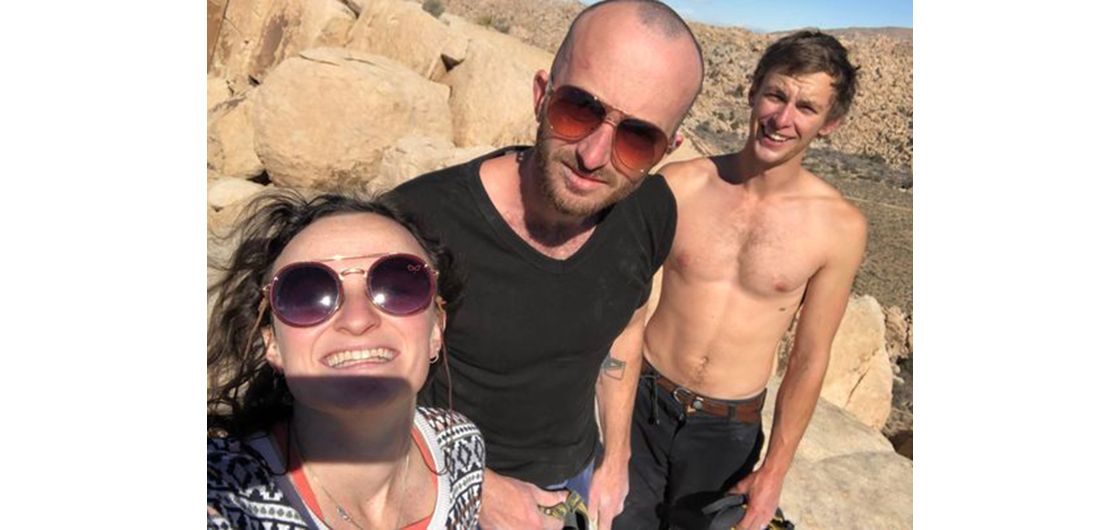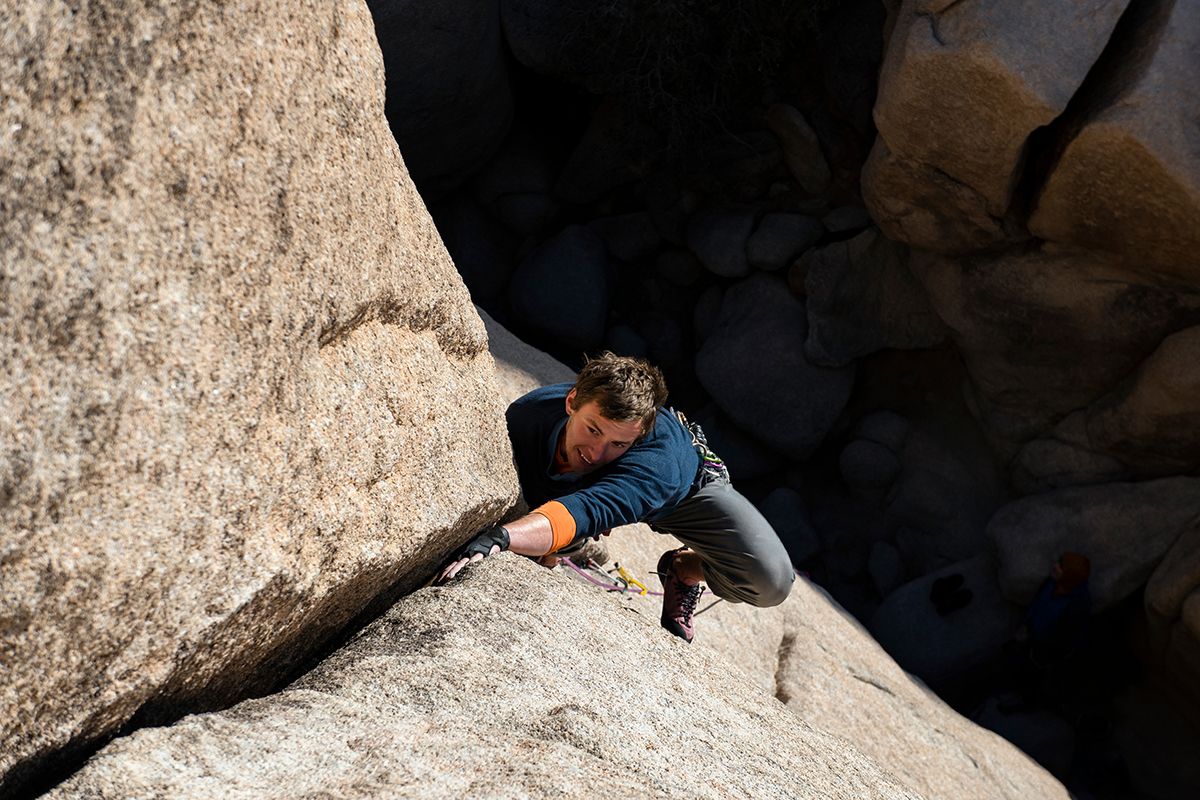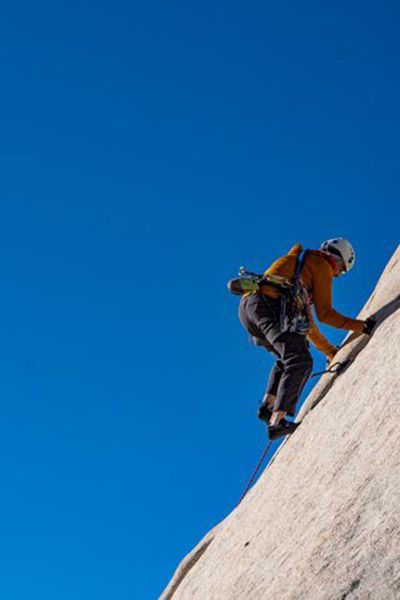
Expedition Report - Fear And Loathing In Joshua Tree
‘Random strong winds’ were the words our local friend Alex used to describe camping in Red Rocks campground. The nature of the desert means that as the sun sets and the temperature drops rapidly underneath the cloudless night sky, air currents move around at drastically unpredictable speeds, with seemingly no pattern at all. Every night a light breeze would be felt on our cheeks, the only exposed bits of skin we couldn’t cover up as we made dinner by headlamp, and I would think to myself that these winds weren’t so strong after all.
‘Random strong winds’ were the words going through my head as our $30 Walmart tent was collapsing in on Erica and myself at three in the morning. The atmospheric occurrences that I previously mentioned showing their full force on our third day in the country. As someone who had previously never experienced desert living, my expectations were cold nights, hot days and an overall lack of moisture. So, when I got out of the tent to ensure that the tie downs were fastened securely, I was somewhat surprised to see a monstrous cloud billowing upwind of us—illuminated by the hectic lights of Las Vegas, which ensures that the time between dusk and dawn shall never be dark. The tarp that we had fastened over the top of the tent in hopes of making it warmer and more windproof was split clean down the middle and flapped vigorously as our symbolic white flag. The winds did not care for our surrender. There is no sensation quite comparable to being physically thrown about by an unseeable force. Camping was no longer an option.
One of the many issues you discover when you begin to pack down your tent in the middle of the night during a storm is that, as you remove your items of clothing and comfort that you fill the tent with to make it a home, you also lighten the tent (which was far more successful at being a kite than it was at being a shelter from the storm). This meant that as I took the final item to our vehicle, turning back to see if Erica had made it out of the tent and was following me back to the car, I instead found that she was riding our blow up mattress inside the inflated kite that was our tent, in uncontrollable fits of laughter that I could not hear over the constant bombardment from that invisible, undeniable force.
***
I wrote those previous paragraphs sitting atop a beige granite formation in Joshua Tree National Park, the occurrences of that night forcing us out of Nevada in search for warmer, drier, all round more pleasant living conditions. The sun has just peaked over the horizon and currently only the tops of the formations, which are a home to a plethora of secure rambles and routes, are catching the light. The gullies below, which hosts our camp as well as many other eager climbers, lie in the shadow of these formations and remain in sub-zero temperatures until the sun gains enough angle to cast its rays upon the hundred-thousand dollar Sprinters, ‘90s rust bucket panel vans and non-walmart brand tents which fill the Hidden Valley Campground.

One of the many things I was not ready for before travelling to the United States was that the locations that we would be climbing in would be easily more beautiful and have much greater scale than I could have imagined. Joshua Tree, as well as Red Rocks, has an incredible vastness which I could happily sit and witness for hours. This vastness means that the amount of information the eye is receiving is far greater than what it would be receiving in the views I have grown accustomed to in the Castle Hill Basin, and so the amount of time that I could happily sit admiring them also increased.
What Joshua Tree holds over many climbing areas that I’ve been to is the architecture of its formations. As a human who spends a lot of time in the Basin appreciating the many ramps and prows, bowls and bulges that the limestone creates, the formations of Joshua Tree appeal to my sensibilities. The granite here, while having possibly the worst texture imaginable for climbing, creates comparable features, searing crack lines, enticing clefts, long meandering slabs. What really appeals to me here is the scale of it all. Being able to wander up quite obvious lines, without rope or any real idea of what you're getting yourself into but having the security of knowing that you could downclimb many other possible lines, questing on and summiting a castle and from that point picking your next tower to conquer, it's a unique but somehow familiar way of passing the time.

Atop this tower I sat alone until Isaac joined me with the first morning coffee, a ritual that would be repeated in action over the next week, although the specific location of the ritual would vary from day to day, tower to tower, the consistency of its pleasure never waivered. Two crows circled the formation in the foreground of the vista we were appreciating, landing atop of it much like we sat on top of ours. Once Erica had made it out of our newly-purchased Outdoor Equipment brand tent, wrapped in an impressive amount of insulating layers and blankets, the only other member of the party left to mention had been up hours before us all, already had a coffee or two and would usually be returning from a scouting mission to explore the day's climbing. John McCallum, New Zealand climbing consigliere, was to advise us in the ways of the old school traditional style and ensure our development as trad climbers was nudged in the right direction.
***
A glorious week has passed since I wrote the previous paragraphs. Joshua Tree was a playground we ran around every day, tackling all sorts of challenges hard and easy, large and small. Each one of us having experienced incredible climbing we couldn't have expected. Isaac took on John Bachar’s benchmark route Leave It To Beaver (5.12), in the process taking his first trad fall, ripping 60% of his protection and learning the valuable lesson of what protection is solid and what is not. A second attempt was all Isaac needed to conquer Bachar’s gymnastic testpiece (which Bachar impressively soloed back in the day). Erica, when asked to pick a memorable moment from a week of memorable moments, mentioned climbing a 5.8 with a forgettable name but an unforgettable experience, indulging what Joshua Tree excels at: secure, low grade climbing. John rediscovered his youth, climbing eight days on and doing more pitches than any of us. Doing so with this incredible joy I recognised from when I first started climbing with his son Alec, many years ago. While I too indulged in the luscious traditional styles, the climb I’ll remember most was an obscure campground boulder which required a great combination of coordination and commitment. A run and jump start to a 2m sideways dyno above a poor landing, a feature and a feeling you don't get to experience that often, flying sideways high off the deck.

Several other images from that week have stuck in my mind: for instance finding quality boulders on our last day that baked in the desert sun, huddling around the campfire at 7pm in the dark of night, feeling the warmth from its flames lick our faces and the cold of the desert tickling our backs, questing up chimneys in approach shoes in the night with little ringtail possums running in and out of cracks around us, watching Isaac, on multiple occasions, pick cactus spikes out of his crocs, having coffees in the formation we called ‘the alcove’, which absorbed all the morning sun and was sheltered from the wind, watching hippies play hacky sack in the dying light of the day.
Joshue Tree is a unique destination, not only for its formations but also the counterintuitive nature of the rock there. The climbs which are in the best condition have had some of the most traffic. The stone is large grain quartzite which, when not having been climbed on, feels as though there is a layer of loose ball bearings on the surface. So, the climbs with high traffic have the smoothest surface and the least ‘skrittle’. Because the rock is so hard, it takes an incredible amount to polish. It can happen, as we found on some of the most popular boulders, but the high-starred, high-trafficked crack climbs had the perfect combination of grippy texture and no skrittle.
We returned to Nevada after John went back to New Zealand. Alec McCallum and Jonty Francis have joined the team and are currently setting themselves up for a six-month stay in the country. It’s snowing now in Red Rocks. As per usual, this gives us the time to focus on our non-climbing specific tasks. As I write these words Erica sits opposite me at the dining table of the small Airbnb we’ve rented, doing a sudoku. Isaac lounges across the three-seater couch reading a book on Indian Creek. Jonty is making the team pancakes and Alec is on the phone to an insurance company, tussling with the easy-to-use American bureaucracy. The snow on Red Rock’s soft sandstone means it will take a few days for the rock to be climbable again, provided it gets enough sun to bake the moisture out of it. The holds here are extremely fragile in places and the moisture turns the sandstone into a poor excuse for stone. Today we will have to figure out what our next adventure will be, until the rock is happy to be climbed on again.
-Matt Corbishley
